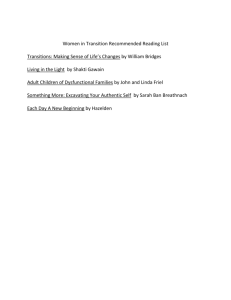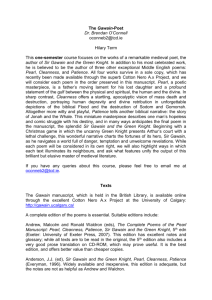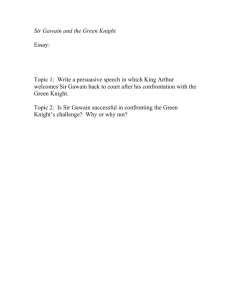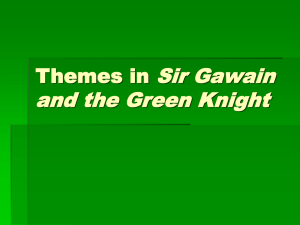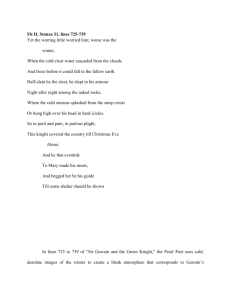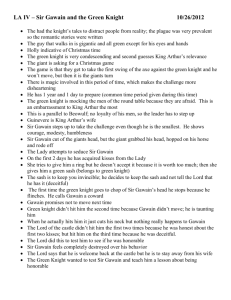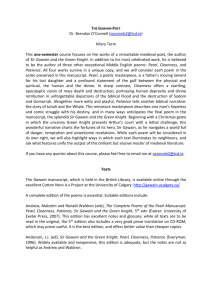Analysis of Sir Gawain And The Green Knight, from lines 566-669
advertisement
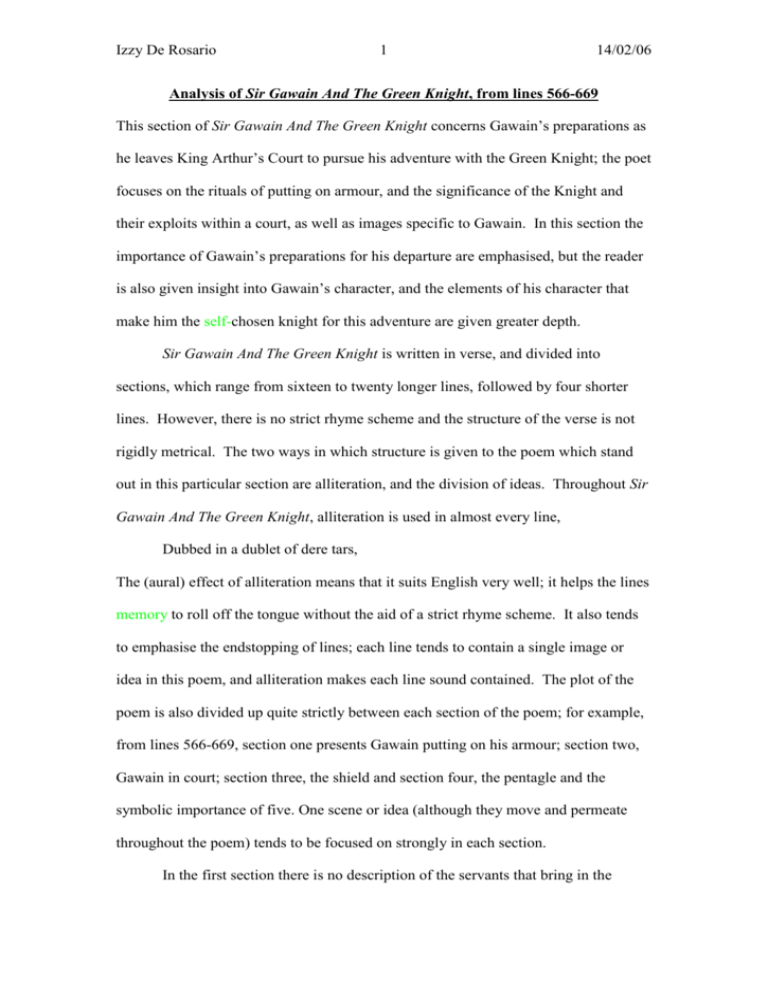
Izzy De Rosario 1 14/02/06 Analysis of Sir Gawain And The Green Knight, from lines 566-669 This section of Sir Gawain And The Green Knight concerns Gawain’s preparations as he leaves King Arthur’s Court to pursue his adventure with the Green Knight; the poet focuses on the rituals of putting on armour, and the significance of the Knight and their exploits within a court, as well as images specific to Gawain. In this section the importance of Gawain’s preparations for his departure are emphasised, but the reader is also given insight into Gawain’s character, and the elements of his character that make him the self-chosen knight for this adventure are given greater depth. Sir Gawain And The Green Knight is written in verse, and divided into sections, which range from sixteen to twenty longer lines, followed by four shorter lines. However, there is no strict rhyme scheme and the structure of the verse is not rigidly metrical. The two ways in which structure is given to the poem which stand out in this particular section are alliteration, and the division of ideas. Throughout Sir Gawain And The Green Knight, alliteration is used in almost every line, Dubbed in a dublet of dere tars, The (aural) effect of alliteration means that it suits English very well; it helps the lines memory to roll off the tongue without the aid of a strict rhyme scheme. It also tends to emphasise the endstopping of lines; each line tends to contain a single image or idea in this poem, and alliteration makes each line sound contained. The plot of the poem is also divided up quite strictly between each section of the poem; for example, from lines 566-669, section one presents Gawain putting on his armour; section two, Gawain in court; section three, the shield and section four, the pentagle and the symbolic importance of five. One scene or idea (although they move and permeate throughout the poem) tends to be focused on strongly in each section. In the first section there is no description of the servants that bring in the Izzy De Rosario 2 14/02/06 armour and dress Gawain; for example, when the armour is brought in (“alle were pay broght”), the construction is passive, which gives the sense that the armour simply materialises. There is also a sense of ritual, as Gawain is dressed in armour methodically from his feet to his head. What is being described is presumably the unique, particular, peculiar ritual of dressing that any knight would undergo; it is not actually definitive to Gawain. What is specific to Gawain however is the quality of the armour. In this section alone the images of the “gyld gere pat glent”, “dublet of dere tars”, “bright baunner”, armour “policed ful clene”, “bright stel ringez” and “gold sporez” stand bright/gold – value, pris, preis, praise – relationship between these out; the imagery of brightness and shining is emphasised from the beginning of the section. Gawain embodies that familiar image of the knight in shining armour. His armour is not merely shining, it is splendid. The “bryght blaunner” and the “knotez of gold” demonstrate his wealth (although it is elaborated later in the passage that Gawain is virtuous and so is worthy of such armour). The imagery also emphasises the way in which Gawain is fortified against danger, His legez lapped in stel with luflych greuez, The word “lapped” means wrapped, and it gives the sense that not only is Gawain Protected/defended or repressed? impenetrable, but also he is in some way trapped, locked in – other verbs like “knaged” and “tachched” have the same effect. In fact, the only image we are given of Gawain himself is of his “thik thrawen thryghez”, which are “coyntlych closed”. In the second section, the focus moves from Gawain to his position in court and the ways in which the other members of the court participate in his departure. The sense of ritual is prevalent in this section, as well as the role of religion as he embarks on his adventure. In this section Gawain is described at Mass, Offred and honoured at the heghe auter. The tense used here is past, but the first section begins with the historic present – the Izzy De Rosario 3 14/02/06 poet has moved from creating a sense of immediacy, to the tone of relating a ritual. The significance of Gawain’s endeavour is made clear, because “the heghe auter” is emphatic, as well as the sense that Gawain not only gives, but receives honour at the Mass. The members of the court also have a role to play, as they escort Gawain to mount his horse; also they are asked for their leave “lufly”, although, as he is already in his armour, he presumably already has it – this is one of the ways in which a sense of ritual is created. Other imagery, such as the way Gryngolet is presented to Gawain, with the saddle, the way Gawain receives the helmet and “hastily hit kisses” gives the impression of the way in which people behave self-consciously, when they are aware they are being watched, as one is during a ritual. At the end of the second section, the poet then returns to describing the band on Gawain’s head in great detail, which returns the focus to the armour Gawain wears and will use, but this time for more clearly in relation to what it reveals about Gawain. The band itself is adorned with but love… “tortors and trulofez”, which symbolise fidelity, and according to the poet, the band is “more o prys” than diamonds – clearly implying Gawain’s worth because of the virtues he embodies, such as fidelity. The poet moves from describing the band to describing the shield in great detail depth. The shield is significant as a focal point for description because it not only protects Gawain, it serves as a means to identifying him, when he is dressed in armour from head to toe. The symbols the shield bears, therefore, reveal not only what protects Gawain, but what he embodies. The poet describes the pentangle on Sir Gawain’s shield as well as giving background to it. Hit is a sygne pat Salamon set sumquyle wisdom and authority The word “sumquyle” means once upon a time, and it gives the poem a sense of time – Sir Gawain and The Green Knight begins with reference to the Trojan war, which Izzy De Rosario 4 14/02/06 places the story in context and history. It gives the reader a sense of time – although the story of Sir Gawain is in the past, it is not so far in the past as the story of Solomon. Solomon’s seal, the pentangle, aligns Gawain with a respected biblical figure associated with wisdom, and so Gawain is not only wise, he is preserved by aspirational/inspirational wisdom. More obviously, the biblical connotations of the pentangle demonstrate that Gawain is protected by a religious force. The pentangle is “depaynt of pure gold hwez” and Gawain too, at the end of this section, is described as being “as golde integrity pured” – these related images underlining the purity of as well as a more personal connection to the meaning of the pentangle are further explored in the final section. It is interesting that poet feels it is necessary to describe the pentangle in such detail, even though …Englych, hit callen Oueral, as I here, the endeles knot. ? I needed to reference my point here, sorry if it doesn’t really make much sense… It slightly undermines the poet’s point, in labouring to describe it so fully, it is known “Oueral” in England – perhaps he is referring to England during the time the period the poet is set. The thematic meaning of the number five becomes convoluted in the final section, as the poet infuses the image with many layers of meaning. Primarily, there are the physical skills of Gawain, who is “funden fautlez in his fyue wittez” and “fyue fyngres” – his ability as a knight is “fautlez”. Next, the pentangle symbolises perfection but compare Luke 6:36 with Matt 5:48, and Mary Gawain’s faith in the five wounds of Christ and the five joys of the Virgin, respectively in what faith allows humans to sustain and in what faith gives us. Finally, the qualities Gawain embodies as a knight, his “fraunchyse and felaghschyp”, “His clannes and his courtaysye”, “And pité, pat passez alle poyntez”. But, ending on this point, having divided up the significance of the pentangle, and emphasised the Izzy De Rosario 5 14/02/06 value of pity above every other quality, the poet then goes on to reject this idea that these qualities can be compartmentalised. Ne samned neuer in no syde, ne sundred nouther The qualities cannot be “sundred” because they all feed into each other – it is the assertion that Gawain’s character is the combination of all these elements. It also stresses the importance of unity of body and soul – it is the combination of his skill as a knight, but also his faith and characteristics of knighthood. This relates back to the images of Gawain putting on his armour. His armour is often linked to images of shining gold, much like his soul which is “as golde pured”. In this way the armour takes on a secondary meaning; Gawain will not just need physical protection, his faith and spiritual qualities will be tested too. The images of Gawain being shut into his armour, becomes images of Gawain shutting out evil, as he prepares to leave the safe haven of the court. Which has been challenged by the green knight The passage ends with Gawain actually leaving – he just rides away, which seems so simple when compared to all the layers of meaning that have been presented with his preparations. But the significance of the preparations is made clear. In this aventure… excerpt the importance of the expedition in relationship to the court is revealed – the value that is placed on it by those around Gawain. Gawain’s virtues, particularly his religious and spiritual virtues are brought to the fore, but also the idea that it is the combination of his virtues that makes him a good knight. Furthermore the idea that Gawain will need protection from physical and spiritual harm is fixed in the reader’s mind, alongside the sense that the journey on which he is about to embark is not merely a physical challenge but a spiritual journey. Suggestions…further analysis of language of pentangle, colour symbolism and verse structure…

